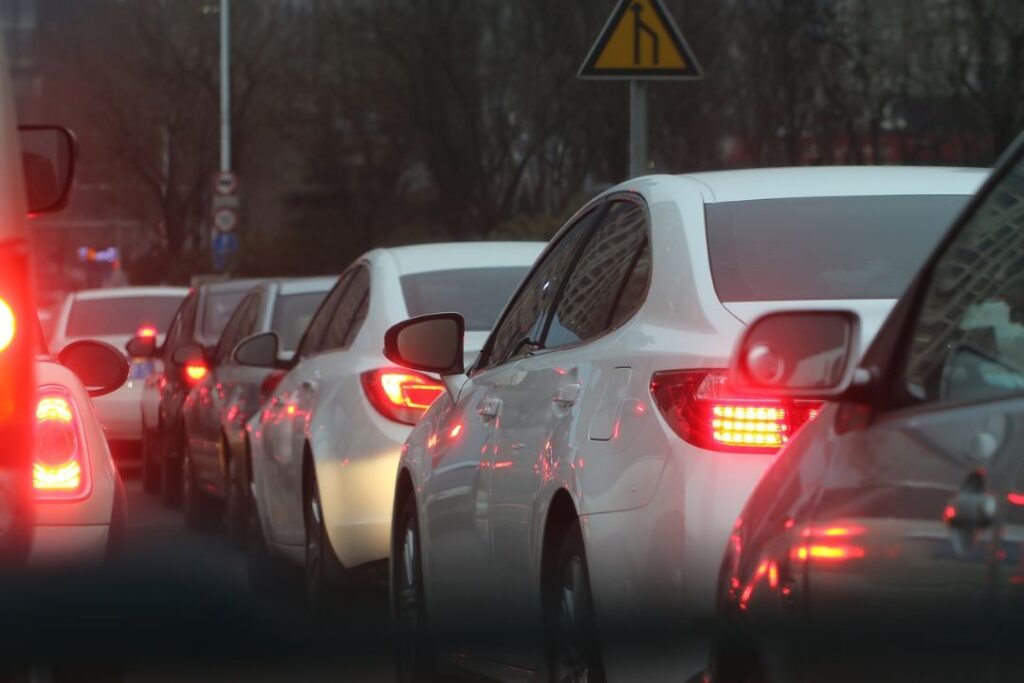Drive along Texas’s busy roads any day of the week, and chances are you’ll get stuck in a traffic jam. You might assume that crashes are less likely with cars moving so slowly, but traffic congestion is a common cause of car accidents.
In this blog post, leading Texas accident attorney Dr. Louis Patino explains how traffic congestion causes car accidents.
What Is Traffic Congestion?
Traffic congestion — or a traffic jam — is the build-up of traffic. An increase in vehicles on the road creates a bottleneck, leading to slower speeds, long queues, and extended trip times. It’s a common issue in urban areas and during peak travel times — such as before the start and after the end of the workday.
Several factors contribute to traffic congestion, including high traffic volume, road work, incidents, poorly timed signals, urbanization, and adverse weather conditions. Each of these elements can disrupt the smooth flow of traffic, resulting in frustrating and often dangerous traffic jams.
How Common Is Traffic Congestion on Texas Roads?
Traffic congestion is a daily reality for many Texas drivers. A report from the Texas A&M Transportation Institute revealed the 100 most congested roads in the state.
The most congested road in Texas is West Loop Freeway / Interstate Highway 610 in Harris County. This road has ranked in the unenviable top position for three consecutive years.
21 of the top 100 most congested roads in the state fall in the San Antonio TxDOT district. The highest ranked — Connally Loop North / Interstate Highway 410 in Bexar County — sits in position 32, up 17 places from position 49 in 2021 and 2022.
Five of the most congested roads are in Hidalgo County, with the highest ranked in position 59. Interstate Highway 2, from U.S. Highway 281 to South 23rd Street, has become increasingly congested over recent years, ranking in position 195 in 2021 and position 97 in 2022.
A Houston Public Media article published in November 2023 comments on claims from the Texas Department of Transportation (TxDOT) that its strategies to reduce road congestion are working. However, the data from Texas A&M Transportation Institute paints a different picture.
Why Traffic Jams Are Dangerous and How Congestion Causes Auto Accidents
You might think that slow-moving traffic presents less of a hazard than open roads where speeding and weaving might be more common. But traffic jams can be highly dangerous.
The stop-and-go nature of traffic congestion makes rear-end collisions particularly more likely, while the proximity of vehicles leaves little room for error and reduces drivers’ abilities to take evasive action.
Some of the most common ways traffic congestion causes car accidents are:
Distracted Driving
We’ve all been stuck in a traffic jam where vehicles inch forward at a snail’s pace, only to stop again for several minutes. During these long waits, drivers are more likely to be tempted to check their phones or “zone out.” If a driver is daydreaming during a traffic jam and a gap appears for them to fill, the driver behind may spot that traffic is moving again and instinctively hit the gas, expecting the driver ahead to do the same. However, if the driver isn’t paying attention, they might find their car being struck from behind.
Aggressive Driving
Traffic delays can cause frustration, especially if a driver has somewhere to be. It only takes the threat of missing an appointment or important meeting — or even just a bad day — for a driver to start acting aggressively. Aggressive drivers are more likely to tailgate, change lanes, make unsafe maneuvers (such as trying to slot into an open spot on the road), and shout, swear, or physically confront other motorists.
Driver Fatigue
Long periods spent in traffic can lead to tiredness, especially if a driver is stuck in a traffic jam on their way home from work. Driver fatigue is a common cause of car accidents, impacting reaction times and overall alertness.
How to Avoid a Car Accident Caused by Traffic Congestion
Navigating traffic congestion requires patience and attentiveness. Not all accidents are avoidable, but you can take steps to minimize your risk.
- Stay alert: Driving is never something you should multitask. Taking your eyes off the road for a moment can be all it takes to trigger a devastating accident, so it is vital to stay focused. Avoid the temptation to reply to a text message during a lull in traffic or do anything else that takes your attention away from the road. If you need to use your phone for navigation or other purposes, use a hands-free device.
- Maintain a safe distance: Most rear-end accidents are caused by drivers failing to maintain a safe distance. You might be tempted to creep as close to the vehicle ahead as possible, but the less space you leave, the harder it is to react to sudden stops or other dangerous behavior. The general rule is to keep at least a three-second gap between your car and the vehicle in front of you. In adverse weather conditions, increase this distance to ensure you have enough time to react.
- Use your mirrors: Regularly check your mirrors and blind spots, especially when changing or merging lanes.
- Stay calm: Traffic jams are frustrating, but getting worked up and aggressive will not make the traffic move faster. Remain patient and try not to react to other drivers engaging in road rage.
- Plan your route: Traffic apps and GPS update in real time based on current road conditions. You can take advantage of this technology to find less congested routes. A trip that might take longer on a quiet day might save you significant time during rush hour or if there’s an accident along your usual route.
- Stay in one lane: Constantly switching lanes in heavy traffic can be dangerous. Choose the lane that best serves your route and stick with it.
What to Do If You’re in an Accident on a Congested Road
You can make all efforts to plan your route and monitor road alerts, but traffic congestion can happen suddenly and unexpectedly. That’s why you must know what to do if you’re in an accident caused by a traffic jam.
- Call 911: You must report an accident to the police immediately if you or anyone else — even if they’re not in your vehicle — is injured in an accident in Texas.
- Get somewhere safe: It might not be possible to move your vehicle after a traffic jam accident, but you should still get to safety. Get out of your car and move to the side of the road if it is safe to do so, being careful to avoid traffic on unaffected lanes. You should not move if you have suffered a neck, back, or spinal cord injury; wait for first responders to attend the scene.
- Exchange information: Speak to the other drivers involved and note their information, including their names, contact details, insurance information, and vehicle details. Doing this now can help you file an insurance claim to recover the costs of repairing your vehicle or getting medical treatment. Don’t forget to note the details of any other eyewitnesses, such as pedestrians or drivers who were not involved in the accident. If you are eligible to file a personal injury claim, their testimony can prove vital to support your story of how the accident happened and show another driver caused the crash.
- Document the scene: When law enforcement responds to an accident scene, their goal is to investigate the crash and clear the scene as quickly as possible to reduce the impact on other drivers and free up traffic to begin moving again. This fact means road conditions can change fast, and evidence proving who caused the accident can deteriorate or be cleared before you can speak to an attorney. Take photos of the accident scene, vehicle damage, road conditions, and your injuries. This evidence will help you show how the accident happened and the damage it caused, which can support an insurance or personal injury claim.
- Seek medical attention: It’s vital to get medical attention after an accident, even if you feel fine. Some injuries don’t appear immediately, but you may need medical treatment later. You can recover the cost of your medical bills from the at-fault party if someone else caused your accident, but you must prove your injuries occurred during the accident. Going to the emergency room or urgent care allows you to document your injuries and — most importantly — get the treatment you need.
- Consult a personal injury lawyer: If your accident was caused by another driver’s negligence, you might be entitled to substantial compensation. Our McAllen and San Antonio accident attorney can assess your accident, tell you if you have a claim, and help you navigate the legal process, from gathering evidence to negotiating a settlement with the at-fault party’s insurance company.
Recovering Compensation after a Traffic Accident
We cannot control when a traffic jam will happen, so you might think that nobody’s at fault when congested traffic causes an accident. But every driver has the responsibility to follow road laws and take reasonable care when driving, and if they fail to do that when in congested traffic, their behavior might constitute negligence under Texas law.
Consider the following scenarios:
- Your car is rear-ended because a driver fails to maintain a safe distance.
- You’re maintaining a safe distance and drive forward as traffic begins to move again. However, the driver ahead is texting on their phone, looks up at the road, and slams the brakes. You have no time to react and bump the back of their car.
- A driver is stuck in a lane and is getting frustrated. They start cursing at you and make an unsafe lane change when they spot a small gap in traffic, causing them to strike the side of your vehicle.
In each of these situations, the other driver has acted negligently, and you might be able to claim compensation for your medical expenses, lost wages, vehicle repairs, and more.
To recover compensation, you must have evidence proving your injuries and the other driver’s fault. This evidence can include the crash report filed by the police, your medical records, and witness statements from experts and those who saw the crash happen. By cooperating with law enforcement, seeking medical attention as soon as possible after the crash, and securing the contact details of those who can corroborate what happened and dispute the other driver’s claims they are not liable, you give yourself the best chance of recovering the compensation you deserve.
Our Texas personal injury lawyer will help you at every stage and take as much as we can off your plate so you can focus on your recovery.
Traffic congestion is an unavoidable part of driving, especially on Texas’s built-up roads, but that does not mean you should suffer when another driver’s negligence causes an accident.
Contact our car accident lawyer in McAllen and San Antonio today to see if you have a claim and learn how much compensation you could be entitled to. Patino Law Firm serves the Rio Grande Valley and Greater San Antonio, from Hidalgo to Schertz and Pharr to Converse. We provide personalized services in Spanish and English and boast hundreds of five-star reviews from satisfied clients we’ve successfully recovered compensation for. We’re available 24/7, and you will never pay legal fees until we win your case.

